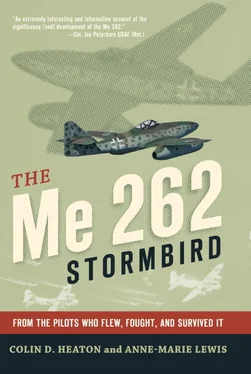Colin Heaton - The Me 262 Stormbird
Здесь есть возможность читать онлайн «Colin Heaton - The Me 262 Stormbird» весь текст электронной книги совершенно бесплатно (целиком полную версию без сокращений). В некоторых случаях можно слушать аудио, скачать через торрент в формате fb2 и присутствует краткое содержание. Город: Minneapolis, MN, Год выпуска: 2012, ISBN: 2012, Издательство: Zenith Press, Жанр: История, на английском языке. Описание произведения, (предисловие) а так же отзывы посетителей доступны на портале библиотеки ЛибКат.
- Название:The Me 262 Stormbird
- Автор:
- Издательство:Zenith Press
- Жанр:
- Год:2012
- Город:Minneapolis, MN
- ISBN:978-0-7603-4263-3
- Рейтинг книги:3 / 5. Голосов: 1
-
Избранное:Добавить в избранное
- Отзывы:
-
Ваша оценка:
The Me 262 Stormbird: краткое содержание, описание и аннотация
Предлагаем к чтению аннотацию, описание, краткое содержание или предисловие (зависит от того, что написал сам автор книги «The Me 262 Stormbird»). Если вы не нашли необходимую информацию о книге — напишите в комментариях, мы постараемся отыскать её.
The story of how the Stormbird came to be is fascinating history, and it comes to life in the hands of noted historian Colin Heaton. Told largely in the words of the German aces who flew it,
provides the complete history of this remarkable airplane from the drawing boards to combat in the skies over the Third Reich. Features two forewords, one by Jorg Czypionka, Me 262 night fighter pilot, and another by historian and author Barrett Tillman.
The introduction of the Me 262 Stormbird jet fighter was a potential game changer for the Germans in World War II, but production delays and a shortage of pilots minimized its impact on the war. Nevertheless, jet engines were the way of the future, and the Stormbird loomed large in the experiences of the World War II pilots who flew and fought the first jet fighter.
In
, Colin D. Heaton (
) covers the iconic fighter in detail, often in the words of the men who flew it or fought it. From Willi Messerschmitt’s original designs, through the early technical difficulties and flight tests, and eventual introduction of the aircraft into the war, Heaton covers the Stormbird’s history in detail alongside fascinating anecdotes from many of Germany’s top aces—and the Allied airmen who went head to head with the futuristic jet while flying their prop-driven planes.
Heaton also covers the political machinations involved in getting approval for the jet—Hitler was personally involved—as well as the infighting among the Luftwaffe’s senior officers, some of whom wanted the aircraft designed as a fighter and others who wanted it designed as a bomber.
The first Me 262 squadron, ultimately designated as JG-7, and Adolf Galland’s squadron, JV-44, are covered extensively, along with the two-seater Me 262 night fighter. Heaton rounds out his narrative with the American perspective of Allied airmen who faced the 262, as well as an analysis of the Stormbird program and its post-war impact.
is a definitive account of this state-of-the-art aircraft. Review
From the Inside Flap “…as operational history, the book is both informative and strongly recommended.”
-
“This is both an intensely factual book about the famed Messerschmitt and a love story. The love story comes in from the authors' obvious fascination with the short-lived Stormbird… Even if you're an Me-262 expert, you're certain to find much that is new here. It's particularly interesting to read how various German pilots learned to use it in combat… If all this sounds intriguing, this is certainly the book for you.”
-












